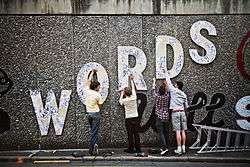Vexta
| Vexta | |
|---|---|
| Born | 20th century |
| Nationality | Australia |
| Known for | Stencil artist and street artist |
| Website |
vexta |
Vexta is an Australian stencil artist and street artist from Melbourne, Victoria.[1]
Career
Beginning her career as an artist predominately working on the streets of Melbourne and Sydney, New South Wales, Vexta is now considered to be one of Australia's most popular and renowned Australian artists working within both urban environments and gallery spaces.[2] Much of her work surrounds the concepts of death, rebirth and the duality of the sexes (an area which she has much to comment on as one of the few famous female street artists in operation), can be seen on walls and galleries all over Australia, America, London, mainland Europe, Mexico and South America, and most recently the Contemporary Art Biennale of India.[3] Vexta has been called "one of Australia's few female stencil artists to have achieved wide recognition" by Lois Stavsky, author of the seminal Graffiti 365 art book.[4]
When Vexta moved from her home town of Sydney to Melbourne in the mid-2000s, she was exposed to much of the thriving underbelly of the local stencil culture, which had been gaining notoriety for close to a decade. Studying and working alongside infamous stencil artists such as Dlux, Optic, Sync, and Ha-Ha, she began cutting and spraying her own stencils.[5] Her colourful, neon-drenched images of fallen figures with feathered wings and her iconic kissing skeletons took over Melbourne's streets and cemented her place within the burgeoning scene, of which she is now a main figure.
Her work has been purchased by the National Gallery of Australia and was prominently featured in the gallery's first-ever street and stencil art exhibition, "Space Invaders", which toured Australian art institutions for two years.[6] She has also completed large-scale commissioned pieces on walls around the world internationally, been included in dozens of group shows.[7]
Work
Vexta's motivation for stencil art is both artistic and socio-political. She has been documented as saying:
"As an artist you take whatever it is you have around you to construct this thing that's important but perhaps can't be expressed in language. My paintings examine these intangible aspects of our lives such as dreams and transient states; the world around us and our place in it."[8]
Her main aim in her work is to connect with the public on an emotional level:
"I want to find and capture what it is that makes us human, the soul of the individual that is at once personal but at the same time deeply universal."[5]
Vexta was one of the few street artists around the world to be personally invited by Banksy, the world's most infamous street artist, to participate in the "Cans Festival", an all-stencil underground event that also featured the likes of Blek le Rat, Vhils, Faile and Pure Evil.[9]
Also internationally, Vexta was one of twelve Australian artists to be chosen to exhibit as part of Young & Free, the largest-ever Australian street art exhibition outside of Australia.[10] This took place in September 2011 at White Walls Gallery in San Francisco, California, where it was a critical and commercial success.[11]
Vexta was featured in the documentary film Rash (2005), which explores the cultural value of street art in Melbourne.[12]
See also
- List of 20th-century women artists
- List of Australian artists
- List of people from Melbourne
- List of Australian street artists
References
- ↑ "Our colourful underbelly". The Age. 5 December 2005. Retrieved 19 December 2007.
- ↑ "A bold, edgy, art-rendering display". The Sydney Morning Herald. 6 September 2007. Retrieved 19 December 2007.
- ↑ "Meet Vexta: street artist extraordinaire". Yen Magazine. October 2011. Retrieved 12 June 2013.
- ↑ "Vexta profile". Yen Magazine. March 2013. Retrieved 12 June 2013.
- 1 2 Smallman & Nyman (2005). Stencil Graffiti Capital: Melbourne. Mark Batty Publisher. Retrieved 19 December 2007.
- ↑ "Stencil art world draws the line". The Age. 9 May 2007. Retrieved 19 December 2007.
- ↑ Dew (2007). Uncommissioned Art: An A to Z of Australian Graffiti. The Miegunyah Press. Retrieved 19 December 2007.
- ↑ "Knock Knock Issue 2". Knock Knock. July 2013. Retrieved 12 June 2013.
- ↑ "Cans Festival location announced". Wooster Collective. May 2008. Retrieved 12 June 2013.
- ↑ "Young & Free interview with Vexta". Vandalog. 8 September 2011. Retrieved 13 June 2013.
- ↑ "Young & Free opening". Fecal Face. 9 September 2013. Retrieved 8 May 2013.
- ↑ Rash (2005) – documentary film about Melbourne street art and graffiti. Official website.
Further reading
- Dew, Christine (2007). Uncommissoned Art – Melbourne. Melbourne: Melbourne University Press. ISBN 978-0-522-85375-9.
- Smallman, Jake; Nyman, Carl (2005). Stencil Graffiti Capital – Melbourne. New York City: Mark Batty Publisher. ISBN 0-9762245-3-4.
- Dean, Bec; Shimada, Hana (2006). The May's Retrospective – May Lane Street Art 2005–2006. Sydney: Graphic Art Mount. ISBN 978-0-646-46429-9.
- Stencil Revolution Member Gallery. (features photos of works exhibited.)
External links
- vexta
.com , her official website.au - Vexta's myspace
- Melbourne: Stencil Graffiti Capital
- Vexta at the Internet Movie Database
